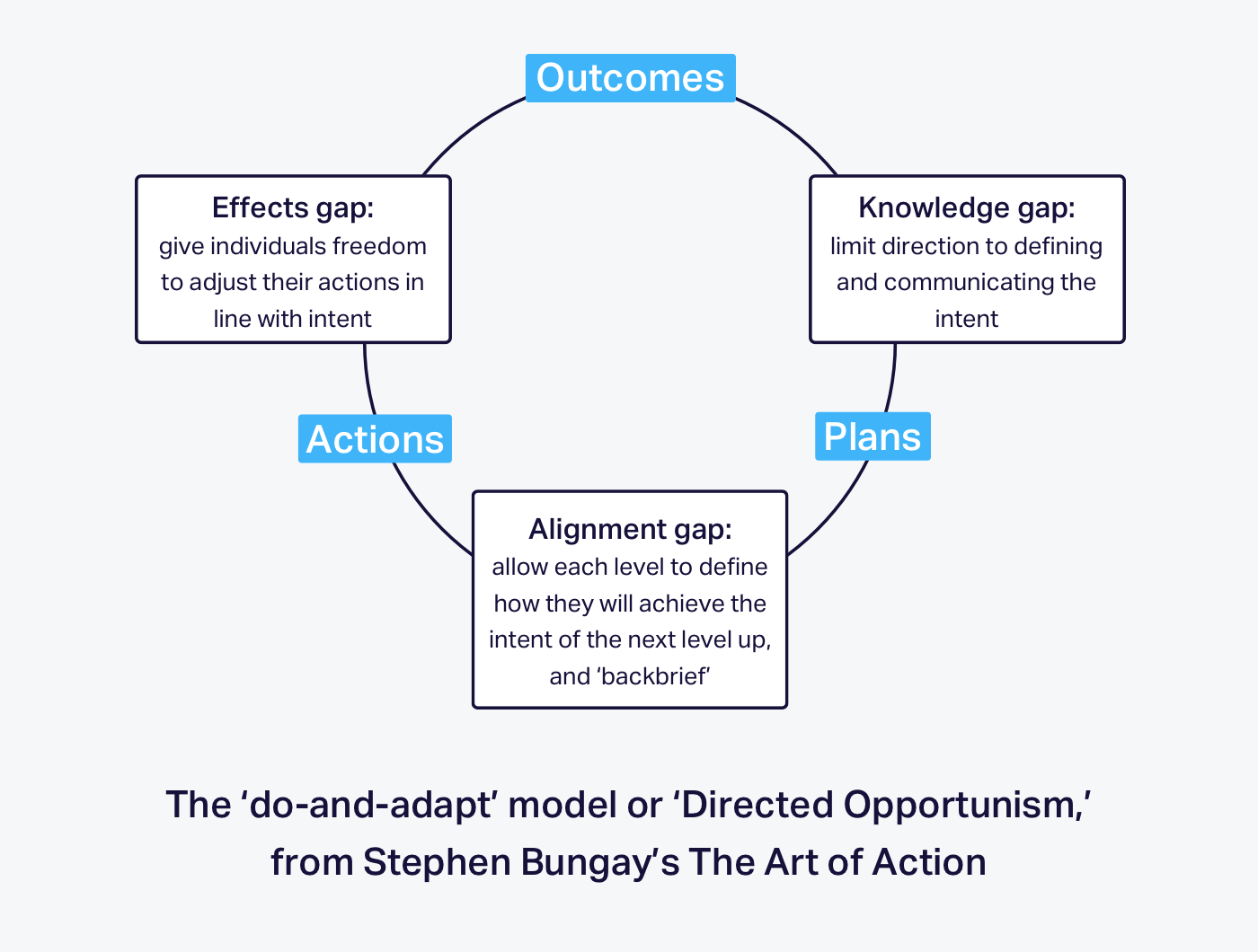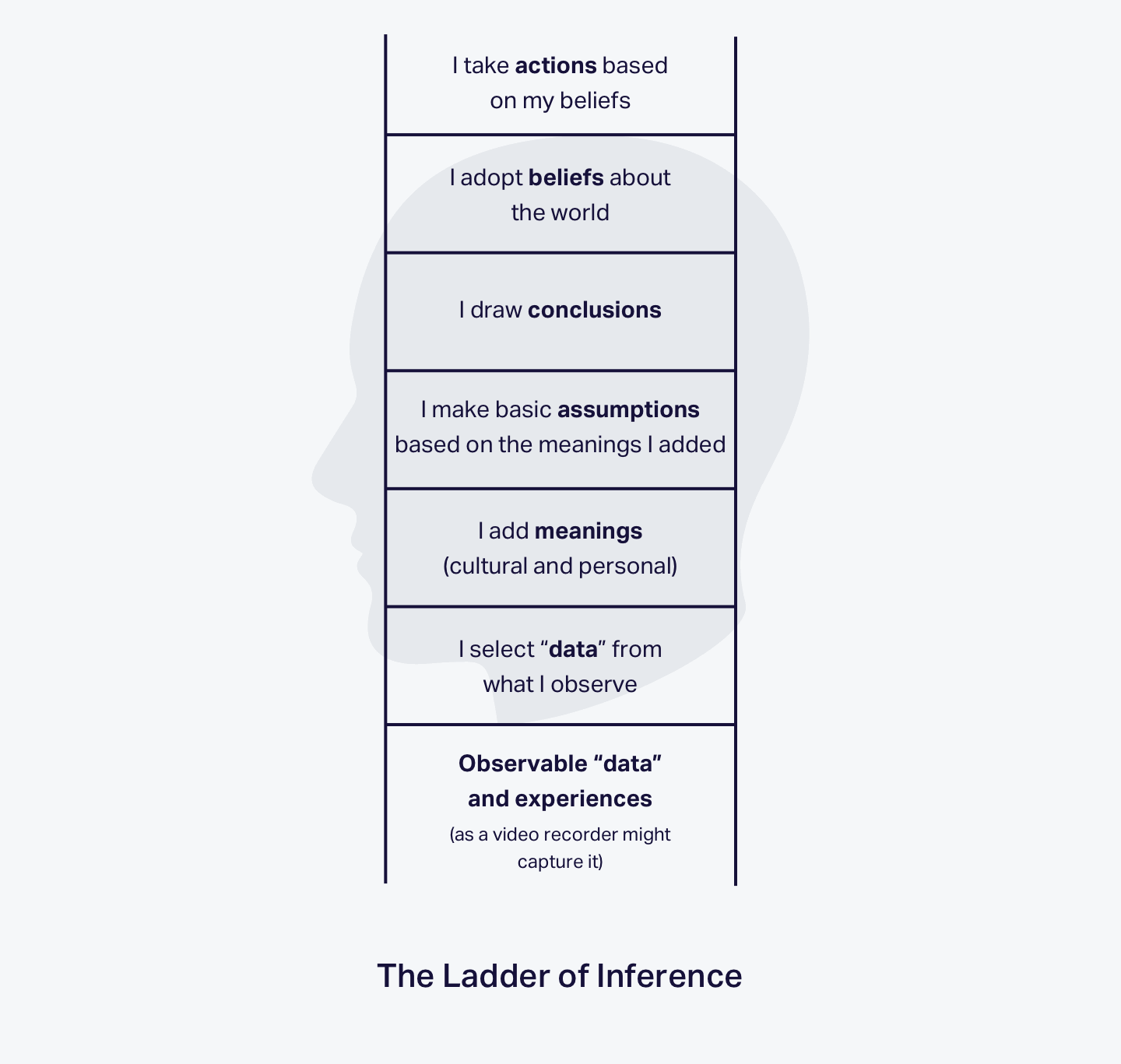To stop micromanaging, and give your team more autonomy, you could just follow the advice of William McKnight, the founder and one-time president of 3M: “Hire good people and leave them alone.”
Unfortunately, it’s not quite so easy in practice, so in this article we’ll cover:
What is micromanagement?

Micromanagement is when a manager tries to control all aspects of their team’s work. These aspects are: their tasks, their techniques, the team-member(s) they work with, and how they use their time. Daniel Pink calls these “the four T’s” in Drive: The Surprising Truth About What Motivates Us.
If you or a colleague is a micromanager, you will probably be:
- Keen for frequent updates on how work is going
- Looped in on every email
- Liberal with the red pen, “correcting” your team’s work
- A looming presence on Google docs
- Detail-oriented and a perfectionist
But more than being a set of habits and “quirks,” micromanagement is often part of a whole philosophy. And, if you have this philosophy — even subconsciously — you’ll assume this about your team:
- They need close supervision
- They need a clear plan, with specific tasks to complete
- They need motivating
Although this philosophy has gone out of fashion, it’s ingrained in most managers’ minds. So even the most forward-thinking among us can revert back to it and end up micromanaging.
Why is micromanaging bad?
Excluding the occasional megalomaniac, no one likes micromanaging. It slows teams down, makes them feel like they’re not trusted, and generally damages morale. Meanwhile, if you’re the micromanager, you have less time for the important stuff like strategy.
But the worst thing about micromanaging is that it stifles your team’s intrinsic motivation.
This is the inner drive that all humans have when we find something interesting or enjoyable. As opposed to extrinsic motivation, which comes out when we’re praised, rewarded, or put under pressure by someone or something.
Spark intrinsic motivation in your team, and it can be incredibly powerful: improving job satisfaction, performance, and even the growth of your company. But, to keep intrinsic motivation alive your team needs autonomy.
Daniel Pink makes the case for autonomy in Drive: The Surprising Truth About What Motivates Us. For example, he points to a study of small businesses by Cornell University. This found that businesses who gave their teams autonomy (and encouraged intrinsic motivation) grew at four times the rate of those that relied on top-down direction. Plus, the companies with more autonomy had one-third the turnover.
With so much at stake, we get why you’d want to stop micromanaging and instead foster autonomy. Particularly if you’re a software company or startup, where creativity and innovation are essential.
How can you stop micromanaging and help your team be self-sufficient?
Lots of articles put managers on the couch and treat micromanagement as a personality trait. But in our view it can also stem from your company’s culture, the leadership tips you’ve had in the past, and even the tools that you use.
With this in mind, here’s a mixture of approaches for stopping micromanaging and fostering autonomy in your team.
1. Set expectations not tasks, with Management by Objectives
Management By Objectives (MBO) is the original approach for stopping micromanagement and fostering autonomy. It was laid out by Peter Drucker in the 1950s, but inspired all kinds of modern frameworks like OKRs, so you’re probably familiar with it.
Here’s the basic principle:
Tell your team exactly what you want to achieve and why, by setting overall objectives. But don’t spell out how to achieve these objectives. Instead, let your team work out what they need to do, and encourage them to set their own goals.
Of course you should still give your team advice for setting goals, and can help to edit their suggestions. But the key is to give them genuine responsibility in the goal-setting — not just “a sense of participation.” If you skip this part, and just use MBO for alignment, then this can become micromanaging in itself.
Allowing your team to set their own goals has several benefits, aside from avoiding micromanagement. Firstly, to choose their own goals, your team will need to properly understand the overall company objectives and business strategy. They’ll also need to understand how their work contributes. And through this understanding you’ll get more alignment and buy-in.
Secondly, by setting their own goals your team will be more engaged. They’ll want to achieve their goals because they’re interested in them, not because they’ve been told to. In other words, they’ll be driven by intrinsic motivation (and we’ve talked about how powerful that can be).
The biggest challenge with this approach is setting effective goals with your team. Get it right, and the goals will draw out the team’s intrinsic motivation. Get it wrong, and they can demotivate and morph back into micromanaging.
To help you and your team set the right goals together, see our article on effective goal-setting.
2. Audit tools, so your team can easily measure their own performance
Even if you let your team set their own goals, they need something else to be autonomous. They need to be able to measure their own performance so they can take independent action.
The measurement aspect is where most companies fall short of autonomy. Because, despite there being a wealth of data to measure, teams don’t always have direct access to it.
Often, this is because of the tools and reports you’re using as a company. For example, maybe your team has to wait for a monthly report to get their data (which gets lost in their inbox anyway). Maybe they have to dig into several complicated tools, spread over multiple teams. Or maybe the tools let them interpret data in multiple different ways, so they have to defer to you for the “right” interpretation.
To solve this problem, start by auditing your tools and data setup. Make sure the data is correct, and cull tools and reports that aren’t essential. This way, your team can get the data they need with minimum help.
To make measurement even easier for your team, you could also consider TV dashboards.
3. Help your team make their own decisions, with Directed Opportunism
Described by Stephen Bungay in The Art of Action, Directed Opportunism is basically a reboot of Management By Objectives. But it introduces some extra tools that will help you stop micromanaging.
Firstly, it introduces the “do-and-adapt” model which looks like this:

Like Management By Objectives, this model gives teams a clear purpose, without telling them what to do. And it allows them to adjust their own actions, and be more agile when faced with problems or opportunities. The extra takeaway, though, is the ‘backbrief, which asks the team to describe exactly what the objective is, and how they plan to tackle it.
While this may sound like micromanagement in itself, it actually avoids it. For your team, it helps them understand the objective, and make their own decisions in line with this. And for you, it gives you confidence that they understand the objective, so you don’t need to be as hands-on.
Here’s a template you could use for your backbrief:
Backbrief template
- Overall project objective
- Context of project
- Constraints and limitations
- Suggested strategy for achieving objectives
- Sub-goals and timelines
We’d recommend that teams put this on an actual document so they can keep referring back to it. Don’t ask for too much detail though, as this defeats the point of clear and concise objectives.
4. Give your team the power to take action, with TV dashboards

TV dashboards put many of the above ideas on autonomy into practice. They do this by helping you:
- Make your intentions crystal clear
As we said in the Management By Objectives section, it’s really important to make intentions clear for your team. Part of this comes down to the way you write your objectives (which is a whole job in itself). But also it comes down to the sharing of information, which is where TV dashboards come in.
A TV dashboard goes somewhere prominent on your office wall. And it clearly displays objectives and other important information for your team.
What’s more, because a TV dashboard is a limited space it discourages you from sharing unnecessary details. So your team can focus on what they actually need to achieve.
Now, depending on the type of team and your management style, you can treat the TV dashboard in two ways. One, you can organize the information and data relevant to your team, and explain what action different metrics or changes in data should trigger. Or, you can follow best practices for organizing your dashboard so the information speaks for itself, and encourage your team to take independent action.
- Give your team the power to measure their performance, and make their own decisions
At the moment your team probably has to wait for performance updates from you. Or they might have to dig into tools like Google Analytics. But with a TV dashboard they can instantly see how they’re doing, at a glance.
This allows them to measure their own performance, and take action. For example, your Customer Support team might see a spike in the number of support tickets on their dashboard, so they could make the decision to focus on customer queries without you needing to nudge them.
The freedom you give your team to make these decisions depends on the type of team, and what type of manager you want to be. But certainly a TV dashboard makes it easier to not micromanage.
5. Encourage free-thinking, with the ‘20 percent time’ approach
If you’re not quite ready to adopt a whole new philosophy, but still want to give your team autonomy, consider the “20 percent” approach. With this, you encourage your team to spend twenty percent of their time on any problem your company needs to solve, so long as it’s not part of their everyday work.
Software companies in particular swear by this approach. For example, Atlassian introduced one day every quarter, called a FedEx day, where the team could work on any software problem that interested them. And these days proved so successful that they decided to give teams 20 percent of their total hours for innovation.
3M also had success with this approach, with the scientist Art Fry famously inventing the Post-it during the company’s 15 percent-time.
And even at Geckoboard we have a version of the idea, with an annual Innovation Week, and five Innovation Days every quarter.
Here’s our advice for making this approach work:
- Start with 10 percent time — this is roughly one afternoon of a five-day work week. Then, if you find it fruitful you can always increase it to 20 percent
- Give the time to everyone — if Engineering get innovation time then other teams like Marketing should get it too. This encourages cross-team collaboration which could result in really novel ideas
- Let your team choose when to innovate — there’ll be times when they have too much regular work on, and they’ll be reluctant to use their free innovation time. So instead of setting the same day for everyone, let people choose a day that suits them
6. Create ‘Psychological Safety,’ so your team feels confident to disagree and take risks
Psychological Safety is a cuddly-sounding term but actually it’s all about candor. It creates an environment where your team can disagree, take risks, and admit mistakes without worrying that they’ll be “told off” or shot down. This is essential for innovation, but if your team is constantly micromanaged then the feeling can dissolve.
To promote Psychological Safety, and avoid — or at the very least counteract — micromanagement, the authors of No Hard Feelings recommend:
- Bad ideas brainstorms — with these, you invite your team to share purposefully ridiculous ideas or ask them to come up with the worst suggestions they can think of. The aim is to remove the pressure that can come with micromanaging, and keep creativity going
- Generative language — if someone has an interesting suggestion, answer with: “Let’s try it!” If you like the essence of someone’s idea, but it needs work, say “Building on that idea…” or use the classic “Yes and…”
Language is very important when it comes to Psychological Safety, and it’s a key feature of micromanagement. Daniel Pink, author of Drive: The Surprising Truth About What Motivates Us, offers similar advice, suggesting that you use ‘noncontrolling language.’ An example would be to avoid words like “must” or “should” and instead use “consider” or “think about.” This subtle change in language gives your team the option to disagree with you.
Another way to promote Psychological Safety is to encourage your team to have healthy debates with you or their manager. But, to make these debates productive, you and your team can use the The Ladder of Inference

Also known as The Process of Abstraction, this tool helps you walk through the thought-process that led you to certain conclusions, and avoid assumptions. For example, you could question the ‘data’ that made you think someone was inexperienced before jumping to the conclusion that they need micromanaging. And likewise, a team-member could look at their ‘selection’ of data that made them see you as the dreaded micromanager.
7. Work towards autonomy with Task Relevant Maturity
We’ve spent this entire article telling you how to stop micromanaging, and why it’s bad. And we maintain: a blanket policy of micromanagement is never good. However, there are specific situations when hands-on management could be helpful for your team. So how do know when it’s appropriate and when to stop?
A practical tool for deciding is Task-Relevant Maturity (TRM). This was invented by the CEO and founder of Intel, Andrew Grove, in High Output Management. With this, you consider a team member’s experience in a specific area. And you base the level of management on this rather than their overall experience.
For example, you might have an extremely experienced team-member join your company, but because they’re not familiar with the product you’d want to give them more detailed instructions at the start. Or, as another example, you might have someone in Marketing who hasn’t got much experience in paid advertising. So you’d give them more direction with this particular channel, but leave them to it on everything else.
The benefit of TRM is that it highlights your team’s strengths whilst picking up on areas where they may need help. This is important because, if you were to go to the opposite extreme of micromanagement and delegate everything, you might miss someone who actually needed help in a specific area.
Remember though, the point isn’t to micromanage more: it’s to manage in a more efficient way. And, by giving someone detailed instructions at the start, the ultimate aim is to help that person be autonomous.
If you’re considering this approach, here’s how to make it productive (read: not annoying):
- Ask your team how experienced and confident they are in specific areas rather than making assumptions. It might be that they’ve been hiding their light under a bushel, so you don’t have to be as hands-on as you first thought
- When you’re asking your team questions about their experience, tell them you’re using the TRM approach. Otherwise they might question your motives and feel like they’re being appraised generally
- Make it clear to your team that you’ll be micromanaging them in certain areas but not everything. And, if possible, create a clear timeline en route to autonomy (OKRs or KPIs can be helpful for this)
Summary
In this article we’ve explored very different ways to stop micromanaging, but they all aim for the same thing. The aim is to stop “controlling” your team — or arguably even managing them, at least in the traditional sense. Instead you want to spend more of your time leading: setting the direction, shaping your company’s culture, and creating an environment where your team is self-motivated, self-sufficient, and free to grow.
Extra reading
- The Practice of Management, by Peter F. Drucker — a management classic that introduces the idea of Management By Objectives, and the importance of ‘self-control’ in teams
- The Art of Action, by Stephen Bungay — a contemporary take on Management By Objectives that explains why teams need better direction and more clarity rather than tighter control
- Drive: The Surprising Truth About What Motivates Us, by Daniel H. Pink — a highly influential book, backed by science, that challenges traditional views on motivation and management
- High Output Management, by Andrew S. Grove — the leader of Intel’s own perspective on how to foster productive teams, with techniques including Task-Relevant Maturity
- No Hard Feelings, by Liz Fosslien and Mollie West Duffy — a practical guide on how to navigate emotions at work, that will help you bring out the best in your team

